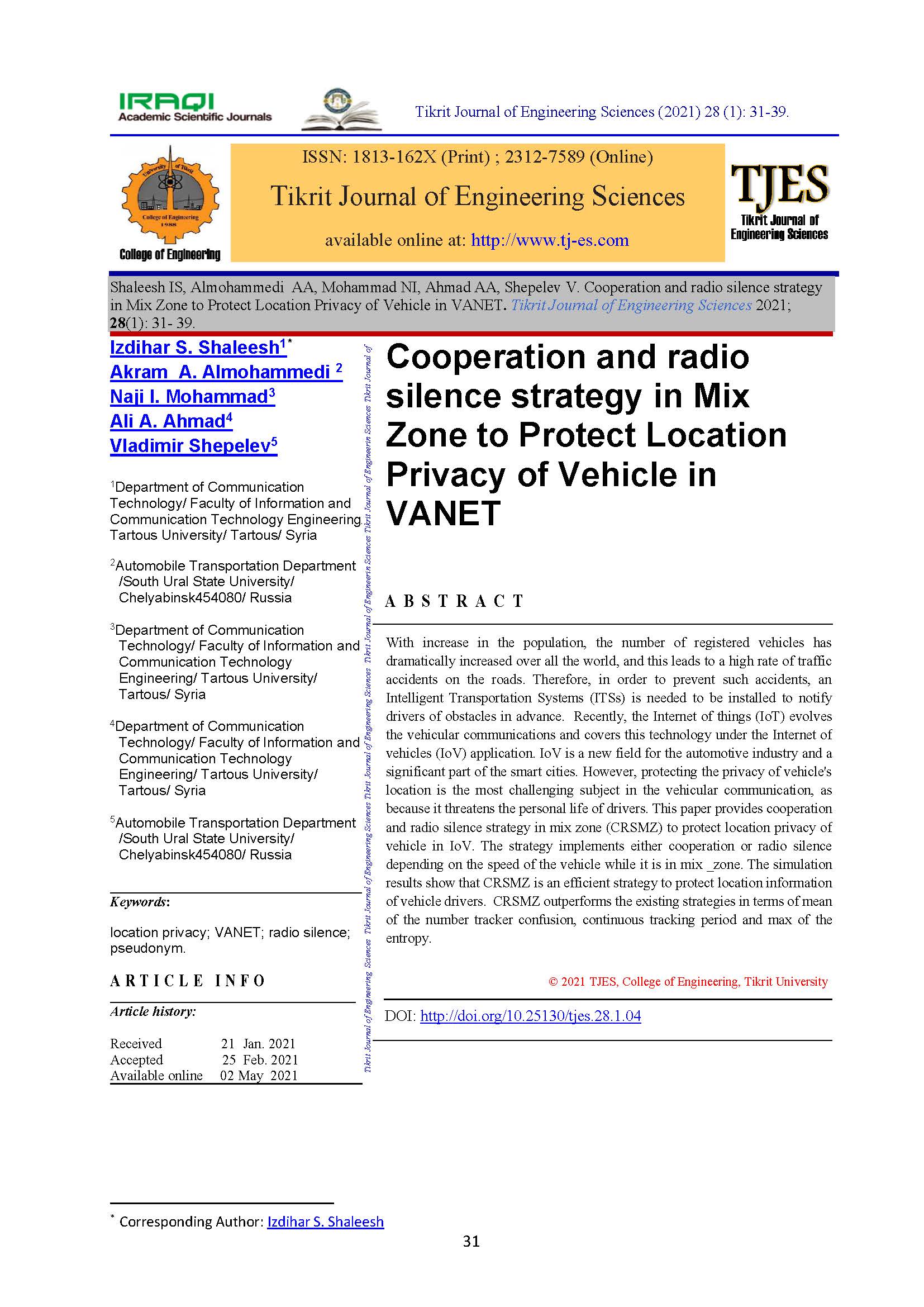Cooperation and radio silence strategy in Mix Zone to Protect Location Privacy of Vehicle in VANET
Main Article Content
Abstract
With increase in the population, the number of registered vehicles has dramatically increased over all the world, and this leads to a high rate of traffic accidents on the roads. Therefore, in order to prevent such accidents, an Intelligent Transportation Systems (ITSs) is needed to be installed to notify drivers of obstacles in advance. Recently, the Internet of things (IoT) evolves the vehicular communications and covers this technology under the Internet of vehicles (IoV) application. IoV is a new field for the automotive industry and a significant part of the smart cities. However, protecting the privacy of vehicle's location is the most challenging subject in the vehicular communication, as because it threatens the personal life of drivers. This paper provides cooperation and radio silence strategy in mix zone (CRSMZ) to protect location privacy of vehicle in IoV. The strategy implements either cooperation or radio silence depending on the speed of the vehicle while it is in mix _zone. The simulation results show that CRSMZ is an efficient strategy to protect location information of vehicle drivers. CRSMZ outperforms the existing strategies in terms of mean of the number tracker confusion, continuous tracking period and max of the entropy.
Metrics
Article Details

This work is licensed under a Creative Commons Attribution 4.0 International License.
THIS IS AN OPEN ACCESS ARTICLE UNDER THE CC BY LICENSE http://creativecommons.org/licenses/by/4.0/
Plaudit
References
Almohammedi, A. A., Noordin, N. K., & Saeed, S. (2016). Evaluating the Impact of Transmission Range on the Performance of VANET. International Journal of Electrical and Computer Engineering, 6(2), 800.
Gasmi, R., & Aliouat, M. (2019, June). Vehicular Ad Hoc NETworks versus Internet of Vehicles-A Comparative View. In 2019 International Conference on Networking and Advanced Systems (ICNAS) (pp. 1-6). IEEE.
Abdullah Q, Abdullah N, Balfaqih M, Shah NS, Anuar S, Almohammedi AA, Salh A, Farah N, Shepelev V. Maximising system throughput in wireless powered sub-6 GHz and millimetre-wave 5G heterogeneous networks. Telkomnika. 2020;18(3):1185-94.
Almohammedi, A. A., & Shepelev, V. (2021). Saturation Throughput Analysis of Steganography in the IEEE 802.11 p Protocol in the Presence of Non-Ideal Transmission Channel. IEEE Access, 9, 14459-14469.
Ahmed MS, Shah NS, Ghawbar F, Jawhar YA, Almohammedi AA. Filtered-OFDM with channel coding based on T-distribution noise for underwater acoustic communication. Journal of Ambient Intelligence and Humanized Computing. 2020: 1-14.
Boualouache, A., Senouci, S. M., & Moussaoui, S. (2016). Vlpz: The vehicular location privacy zone. Procedia Computer Science, 83, 369-376.
Boualouache, A., & Moussaoui, S. (2014, June). S2si: A practical pseudonym changing strategy for location privacy in vanets. In 2014 International Conference on Advanced Networking Distributed Systems and Applications (pp. 70-75). IEEE
Ullah, I., Wahid, A., Shah, M. A., & Waheed, A. (2017, April). VBPC: Velocity based pseudonym changing strategy to protect location privacy of vehicles in VANET. In 2017 International Conference on Communication Technologies (ComTech) (pp. 132-137). IEEE.
Boualouache, A., & Moussaoui, S. (2017). TAPCS: Traffic-aware pseudonym changing strategy for VANETs. Peer-to-Peer Networking and Applications, 10(4), 1008-1020.
Song, J. H., Wong, V. W., & Leung, V. C. (2010). Wireless location privacy protection in vehicular ad-hoc networks. Mobile Networks and Applications, 15(1), 160-171.
Gerlach, M., & Guttler, F. (2007, April). Privacy in VANETs using changing pseudonyms-ideal and real. In 2007 IEEE 65th Vehicular Technology Conference-VTC2007-Spring (pp. 2521-2525). IEEE.
Buttyán, L., Holczer, T., Weimerskirch, A., & Whyte, W. (2009, October). Slow: A practical pseudonym changing scheme for location privacy in vanets. In 2009 IEEE Vehicular Networking Conference (VNC) (pp. 1-8). IEEE.
Pan, Y., & Li, J. (2013). Cooperative pseudonym change scheme based on the number of neighbors in VANETs. Journal of Network and Computer Applications, 36(6), 1599-1609.
Emara, K., Woerndl, W., & Schlichter, J. (2013, June). Vehicle tracking using vehicular.
Izdihar, S., Naji, M., Ali, A(2019, September). The Effect of Suggested Mix-Zones on the Privacy Protection of Vehicles' Location in VANET Networks. (41).Al Baath Magazine.
Liao, J., & Li, J. (2009, December). Effectively changing pseudonyms for privacy protection in vanets. In 2009 10th International Symposium on Pervasive Systems, Algorithms, and Networks (pp. 648-652). IEEE
Izdihar Sh (2020). The Privacy protection of the vehicle location in
vehicular ad hoc networks. Journal of Bakht Al-Ridha, (31).
Hassan, A .,Ali, A., Nawaf M (2007). Replacement of VRRP Protocol by Router Clustering. Tishreen University Journal.(29).





